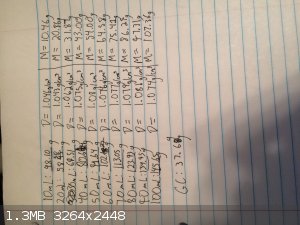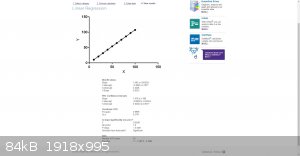Velzee
Hazard to Others
  
Posts: 379
Registered: 19-8-2015
Location: New York
Member Is Online
Mood: Taking it easy
|
|
Problems with finding concentration of HCl.
Recently, I obtained two gallon jugs of store-grade HCl, and, just for fun, I thought I'd confirm the concentration of the acid. Noting the MSDS'
claim of 20%, I first used the density route and found the concentration to be approximately 11%, as the mass of 10.0mL of the acid was 10.53g, which
came out to a density of 1.053g/cc.
Confused, I performed a ghetto and poor titration using LiOH and found that the concentration was 30.1%. I knew this wasn't correct, so today, I
performed another, better, trial using K2CO3 because I don't have a base available and I don't want to waste my LiOH. I found the concentration to be
18.3%.
My question is how can I find out the accurate concentration of the acid? Any suggestions would be appreciated.
[Edited on 4/20/2016 by Velzee]
[Edited on 4/20/2016 by Velzee]
Check out the ScienceMadness Wiki: http://www.sciencemadness.org/smwiki/index.php/Main_Page
"All truth passes through three stages. First, it is ridiculed. Second, it is violently opposed. Third, it is accepted as being self-evident."
—Arthur Schopenhauer
"¡Vivá Cristo Rey!"
—Saint José Sánchez del Río |
|
|
DistractionGrating
Hazard to Self
 
Posts: 68
Registered: 3-4-2014
Member Is Offline
Mood: Precipitated
|
|
Standardize against a primary standard. Sodium carbonate is the typical go-to primary standard for this purpose. Recrystallize Na2CO3 two or three
times, and then dry at 110C for a couple of hours, then cool in a dessicator before using.
|
|
|
Velzee
Hazard to Others
  
Posts: 379
Registered: 19-8-2015
Location: New York
Member Is Online
Mood: Taking it easy
|
|
Quote: Originally posted by DistractionGrating  | | Standardize against a primary standard. Sodium carbonate is the typical go-to primary standard for this purpose. Recrystallize Na2CO3 two or three
times, and then dry at 110C for a couple of hours, then cool in a dessicator before using. |
Just did it and got 17.7%. Any way to confirm this besides more trials?
EDIT: I just realized that I made an error on my trials prior to my latest one. My first trial, I got 30.1%. For the second one, I got 18.3%. So, my
more proper titrations were closer to the MSDS of 20%. But the density is still off a little...
[Edited on 4/20/2016 by Velzee]
Check out the ScienceMadness Wiki: http://www.sciencemadness.org/smwiki/index.php/Main_Page
"All truth passes through three stages. First, it is ridiculed. Second, it is violently opposed. Third, it is accepted as being self-evident."
—Arthur Schopenhauer
"¡Vivá Cristo Rey!"
—Saint José Sánchez del Río |
|
|
mayko
International Hazard
    
Posts: 1218
Registered: 17-1-2013
Location: Carrboro, NC
Member Is Offline
Mood: anomalous (Euclid class)
|
|
That does seem like a pretty big difference. Something you might try is measuring the mass of a number of different volumes and calculate a linear
regression; this will smooth out the uncertainty in a single measurement:
https://topologicoceans.wordpress.com/2013/01/30/lablulz-den...
al-khemie is not a terrorist organization
"Chemicals, chemicals... I need chemicals!" - George Hayduke
"Wubbalubba dub-dub!" - Rick Sanchez
|
|
|
blogfast25
International Hazard
    
Posts: 10562
Registered: 3-2-2008
Location: Neverland
Member Is Offline
Mood: No Mood
|
|
Quote: Originally posted by Velzee  | Recently, I obtained two gallon jugs of store-grade HCl, and, just for fun, I thought I'd confirm the concentration of the acid. Noting the MSDS'
claim of 20%, I first used the density route and found the concentration to be approximately 11%, as the mass of 10.0mL of the acid was 10.53g, which
came out to a density of 1.053g/cc.
Confused, I performed a ghetto and poor titration using LiOH and found that the concentration was 30.1%. I knew this wasn't correct, so today, I
performed another, better, trial using K2CO3 because I don't have a base available and I don't want to waste my LiOH. I found the concentration to be
18.3%.
My question is how can I find out the accurate concentration of the acid? Any suggestions would be appreciated.
|
W/o knowing you precise conditions of titration you used no one can really advise you on what you're doing wrong.
Titrations are allegedly 'easy' but only when you know what you're doing and get it absolutely right.
Don't take that personal. 
Quote: Originally posted by DistractionGrating  | | Standardize against a primary standard. Sodium carbonate is the typical go-to primary standard for this purpose. Recrystallize Na2CO3 two or three
times, and then dry at 110C for a couple of hours, then cool in a dessicator before using. |
While good advice, I doubt if the wild fluctuations in his results can be explained by lack of standardisation.
[Edited on 21-4-2016 by blogfast25]
|
|
|
DJF90
International Hazard
    
Posts: 2266
Registered: 15-12-2007
Location: At the bench
Member Is Offline
Mood: No Mood
|
|
Lithium hydroxide is usually supplied as a monohydrate, which may explain your high result when using it for titration.
EDIT
Taking into account a factor of 24/42 (LiOH/LiOH+H2O) for the monohydrate gives 17.2 % HCl, consistent with your other titrations.
[Edited on 21-4-2016 by DJF90]
|
|
|
JJay
International Hazard
    
Posts: 3440
Registered: 15-10-2015
Member Is Offline
|
|
What indicator are you using for the titration?
|
|
|
Velzee
Hazard to Others
  
Posts: 379
Registered: 19-8-2015
Location: New York
Member Is Online
Mood: Taking it easy
|
|
Phenolphthalein. I also have a pH meter that I didn't use, if that helps.
Check out the ScienceMadness Wiki: http://www.sciencemadness.org/smwiki/index.php/Main_Page
"All truth passes through three stages. First, it is ridiculed. Second, it is violently opposed. Third, it is accepted as being self-evident."
—Arthur Schopenhauer
"¡Vivá Cristo Rey!"
—Saint José Sánchez del Río |
|
|
JJay
International Hazard
    
Posts: 3440
Registered: 15-10-2015
Member Is Offline
|
|
Hmm... I have to wonder why you are getting such range in your calculations.
|
|
|
Velzee
Hazard to Others
  
Posts: 379
Registered: 19-8-2015
Location: New York
Member Is Online
Mood: Taking it easy
|
|
Okay, so I first measured the mass of the graduated cylinder I used(labeled as "GC"), then I proceeded to find the mass("M") of multiple samples of
the acid (from 10mL,20mL,...100mL), and then I found the densities of each("D"):
https://i.imgur.com/F1pWv7q.jpg
And then I went onto calculate a linear regression from the data using my graphing calculator. I was greeted with this data(please forgive me as I
have not calculated a regression line in a while):
https://i.imgur.com/ISDyDuv.jpg
With the formula of the line being y=.00036666667x+1.049133333
I am not really sure what to do with this...
[Edited on 4/21/2016 by Velzee]
 
Check out the ScienceMadness Wiki: http://www.sciencemadness.org/smwiki/index.php/Main_Page
"All truth passes through three stages. First, it is ridiculed. Second, it is violently opposed. Third, it is accepted as being self-evident."
—Arthur Schopenhauer
"¡Vivá Cristo Rey!"
—Saint José Sánchez del Río |
|
|
gdflp
Super Moderator
      
Posts: 1320
Registered: 14-2-2014
Location: NY, USA
Member Is Offline
Mood: Staring at code
|
|
Sorry if this comes across as a PSA, but please don't use imgur or other external hosting services. Rather, attach pictures and other files directly
to the forum using the built-in attachment feature. Those sorts of image hosting services will drop the image after a relatively short period of
time, around a few years, and this results in old threads becoming very confusing. I've spent many hours trying to recover as many images as I can
from various backups, but most of them are simply unrecoverable.
|
|
|
Velzee
Hazard to Others
  
Posts: 379
Registered: 19-8-2015
Location: New York
Member Is Online
Mood: Taking it easy
|
|
Quote: Originally posted by gdflp  | | Sorry if this comes across as a PSA, but please don't use imgur or other external hosting services. Rather, attach pictures and other files directly
to the forum using the built-in attachment feature. Those sorts of image hosting services will drop the image after a relatively short period of
time, around a few years, and this results in old threads becoming very confusing. I've spent many hours trying to recover as many images as I can
from various backups, but most of them are simply unrecoverable. |
Done. I know they appear sideways, but once you click on them, they're normally positioned.
Check out the ScienceMadness Wiki: http://www.sciencemadness.org/smwiki/index.php/Main_Page
"All truth passes through three stages. First, it is ridiculed. Second, it is violently opposed. Third, it is accepted as being self-evident."
—Arthur Schopenhauer
"¡Vivá Cristo Rey!"
—Saint José Sánchez del Río |
|
|
JJay
International Hazard
    
Posts: 3440
Registered: 15-10-2015
Member Is Offline
|
|
Solution densities often follow nonlinear trends with respect to concentration... I would be especially wary of extrapolation. You'll probably need
quite a few data points to produce a nonlinear regression model that has better prediction accuracy than a simple first order regression, though.
[Edited on 21-4-2016 by JJay]
|
|
|
mayko
International Hazard
    
Posts: 1218
Registered: 17-1-2013
Location: Carrboro, NC
Member Is Offline
Mood: anomalous (Euclid class)
|
|
Quote: Originally posted by Velzee  |
And then I went onto calculate a linear regression from the data using my graphing calculator. I was greeted with this data(please forgive me as I
have not calculated a regression line in a while):
https://i.imgur.com/ISDyDuv.jpg
With the formula of the line being y=.00036666667x+1.049133333
|
Just eyeballing the written data in your notebook, it seems clear that the mass is increasing by about 10 g for every 10 mL added, so the measured
density should be approximately 1. The reported density (a, in the second image) is 3-4 orders of magnitude off, so something somewhere has gone
terribly wrong.
I suspect that you aren't correctly specifying the dependent and independent variables. I don't know about the specifics of your calculator, or what
you entered though.
EDIT: in particular, I bet that you are using measured density as the dependent variable, rather than measured mass!
(You might also just average the individual density measurements. EDIT actually, eyeballing the written data again,
it looks like the calculated density starts off low and slowly converges on ~1.07. You can probably confirm this graphically. This could be explained
if the first ~5-10 mL of the graduated cylander actually holds a little more than that; in my experience they often aren't accurate at the very bottom
of the scale. If the divisions between markings are accurate though, this small bias will be diluted from the average density with increasing volumes,
and could be removed by excluding the first few points from the regression)
[Edited on 22-4-2016 by mayko]
al-khemie is not a terrorist organization
"Chemicals, chemicals... I need chemicals!" - George Hayduke
"Wubbalubba dub-dub!" - Rick Sanchez
|
|
|
mayko
International Hazard
    
Posts: 1218
Registered: 17-1-2013
Location: Carrboro, NC
Member Is Offline
Mood: anomalous (Euclid class)
|
|
Quote: Originally posted by JJay  | Solution densities often follow nonlinear trends with respect to concentration... I would be especially wary of extrapolation. You'll probably need
quite a few data points to produce a nonlinear regression model that has better prediction accuracy than a simple first order regression, though.
[Edited on 21-4-2016 by JJay] |
Why extrapolate when you can interpolate?
http://www.handymath.com/cgi-bin/hcltble3.cgi?submit=Entry
al-khemie is not a terrorist organization
"Chemicals, chemicals... I need chemicals!" - George Hayduke
"Wubbalubba dub-dub!" - Rick Sanchez
|
|
|
JJay
International Hazard
    
Posts: 3440
Registered: 15-10-2015
Member Is Offline
|
|
Parametrically estimating cross entropy? I assume this is a rhetorical question.
|
|
|
Velzee
Hazard to Others
  
Posts: 379
Registered: 19-8-2015
Location: New York
Member Is Online
Mood: Taking it easy
|
|
Quote: Originally posted by mayko  |
I suspect that you aren't correctly specifying the dependent and independent variables. I don't know about the specifics of your calculator, or what
you entered though.
EDIT: in particular, I bet that you are using measured density as the dependent variable, rather than measured mass!
[Edited on 22-4-2016 by mayko] |
You were correct—I used the densities as the dependent variables. So, I made an attempt at another regression, this time, with the masses of each
sample as the dependent variable:

And also, in the graduated cylinder, 10g of distilled water appear to be ~10.9 mL or approximately 1mL off.
[Edited on 4/22/2016 by Velzee]
Check out the ScienceMadness Wiki: http://www.sciencemadness.org/smwiki/index.php/Main_Page
"All truth passes through three stages. First, it is ridiculed. Second, it is violently opposed. Third, it is accepted as being self-evident."
—Arthur Schopenhauer
"¡Vivá Cristo Rey!"
—Saint José Sánchez del Río |
|
|
Velzee
Hazard to Others
  
Posts: 379
Registered: 19-8-2015
Location: New York
Member Is Online
Mood: Taking it easy
|
|
bump(I think I'm allowed to do this? Please forgive me if I'm not)
Check out the ScienceMadness Wiki: http://www.sciencemadness.org/smwiki/index.php/Main_Page
"All truth passes through three stages. First, it is ridiculed. Second, it is violently opposed. Third, it is accepted as being self-evident."
—Arthur Schopenhauer
"¡Vivá Cristo Rey!"
—Saint José Sánchez del Río |
|
|
Velzee
Hazard to Others
  
Posts: 379
Registered: 19-8-2015
Location: New York
Member Is Online
Mood: Taking it easy
|
|
Quote: Originally posted by JJay  | | The Y intercept should be 0 or much closer to 0. How are you measuring the volume of the solution? For that matter, how are you measuring its weight?
|
I use a graduated cylinder, as well as a 200 gram digital scale.
Check out the ScienceMadness Wiki: http://www.sciencemadness.org/smwiki/index.php/Main_Page
"All truth passes through three stages. First, it is ridiculed. Second, it is violently opposed. Third, it is accepted as being self-evident."
—Arthur Schopenhauer
"¡Vivá Cristo Rey!"
—Saint José Sánchez del Río |
|
|
JJay
International Hazard
    
Posts: 3440
Registered: 15-10-2015
Member Is Offline
|
|
Ok, I just saw the part about how your graduated cylinder isn't very accurate. You want to correct the measurements before you plug them into the
regression. You should get a 0 Y-intercept with the slope as the density.
|
|
|
Velzee
Hazard to Others
  
Posts: 379
Registered: 19-8-2015
Location: New York
Member Is Online
Mood: Taking it easy
|
|
Quote: Originally posted by JJay  | | Ok, I just saw the part about how your graduated cylinder isn't very accurate. You want to correct the measurements before you plug them into the
regression. You should get a 0 Y-intercept with the slope as the density. |
But, how do I correct them? Should I just subtract 0.9 mL from each answer, or...?
Check out the ScienceMadness Wiki: http://www.sciencemadness.org/smwiki/index.php/Main_Page
"All truth passes through three stages. First, it is ridiculed. Second, it is violently opposed. Third, it is accepted as being self-evident."
—Arthur Schopenhauer
"¡Vivá Cristo Rey!"
—Saint José Sánchez del Río |
|
|
JJay
International Hazard
    
Posts: 3440
Registered: 15-10-2015
Member Is Offline
|
|
You could plug them in uncorrected and look at the slope as the density... that might actually produce better results, depending on how accurate your
0.9 estimate is....
|
|
|
Velzee
Hazard to Others
  
Posts: 379
Registered: 19-8-2015
Location: New York
Member Is Online
Mood: Taking it easy
|
|
Quote: Originally posted by JJay  | | You could plug them in uncorrected and look at the slope as the density... that might actually produce better results, depending on how accurate your
0.9 estimate is.... |
With a density of 1.083g/mL, I get a concentration of ~17.7%. That's cool. Close to my titrations, too.
EDIT: Apparently, 17.7% is exactly what I got for one of my titrations. Wow!
[Edited on 4/23/2016 by Velzee]
Check out the ScienceMadness Wiki: http://www.sciencemadness.org/smwiki/index.php/Main_Page
"All truth passes through three stages. First, it is ridiculed. Second, it is violently opposed. Third, it is accepted as being self-evident."
—Arthur Schopenhauer
"¡Vivá Cristo Rey!"
—Saint José Sánchez del Río |
|
|